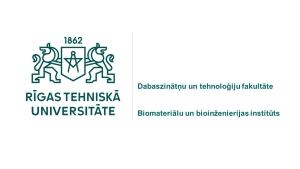2018 in photographs, videos and radio broadcasts
One more productive year 🙂
LR1 radio broadcast “Zināmais nezināmajā” – has shed a light on how are different biomaterials made and how is the research on making new implants being done. The aforementioned subjects have been discussed by Dagnija Loča, head of the Rudolfs Cimdins Riga Biomaterials Innovations and Development Centre, Riga Technical University. “Biomaterial can be synthesized in the laboratory, or taken from nature, but the main thing is that it is well compatible with the human body. It sounds simple, but it is the most difficult to make human spare parts…”. The rest of this eclectic interview can be found here.
LR1 radio broadcast “Zināmais nezināmajā” – Science for humans – this can certainly be applied to the biomaterial’s field. Combining knowledge and research in chemistry, physics, engineering and medicine can make the activity of people undemanding and effortless. One of the examples of how this can be done is manufacturing artificial hips, jaws and other parts of the human body. This is what Jānis Ločs does on a daily basis. He founded the Baltic Biomaterials Centre of Excellence. The center is expected to offer a comprehensive range of services to industry, encompassing a range from the laboratory development to the clinical research.
The Doctor of Engineering, Jānis Ločs, RTU Scientists of the Year, has given a speech about the establisment of the Baltic Biomaterials Centre of Excellence within the programm “Zināmais nezināmajā”.
LR1 radio broadcast “Zināmais nezināmajā” – on the cultivation of edible microalgae – spirulina and the set-up of the bioreactors. Spirulina is a plant-based source of omega-3 acids, proteins and antioxidants. Due to its valuable properties, it is known as “the super food”. One example of those characteristics is that spirulina contains up to three times more protein than meat or legumes contain.
Traditionally, these tropical microalgae have been harvested from shallow ponds in Africa, where they have been used as a food source for hundreds of years. On an industrial scale, they have been cultivated in desert areas in the United States, China and other tropical and subtropical countries, where they are using low-yield methods. On the subject of the spirulina cultivation in Latvia, doctors of engineering from RTU MSAC IGCE Agnese Stunda-Zujeva and Kristīne Veģere have given an interesting interview.
LR1 radio broadcast “Zināmais nezināmajā” – Arita Dubņika, RTU New Scientist of the Year and researcher of Rudolfs Cimdins Riga Biomaterials Innovations and Development Centre has given the interview regarding bioadhesive materials.
LR1 radio broadcast “Zināmais nezināmajā” – the researcher Olita Medne from the RTU Institute of General Chemical Engineering, explains about the design of environmentally friendly spray coatings for outdoor use. The coating created by RTU scientists, in addition to being environmentally friendly, contains Latvian clay, wood fibers and recycled paper, as well as components that ensure better material adhesion. The coating prevents the waste from dispersing in the wind and limits the spread of unpleasant odors in the environment.
Jānis Ločs talked about science at the international level in the interview for the magazine Innovation.
“Perhaps male scientists believe that science is the presentation of an exact science and there is only a place for a man due to their stereotypical technical way of thinking, which is needed, but women in science break all those stereotypes. A woman can look at the things from a million different points of view,” says Kristīne Šalma-Ancāne, a scientist from the Rudolfs Cimdins Riga Biomaterials Innovations and Development Centre for the LNT program “900 sekundes”.


